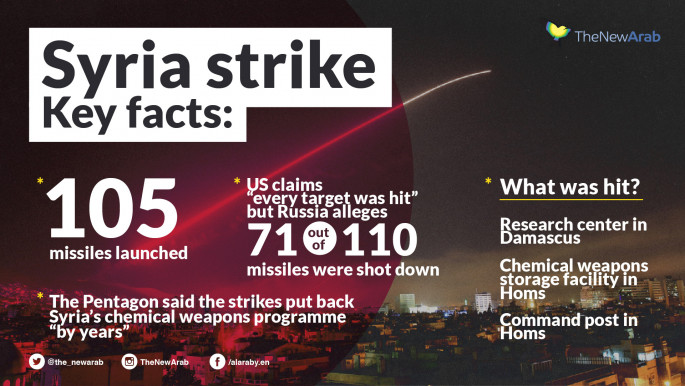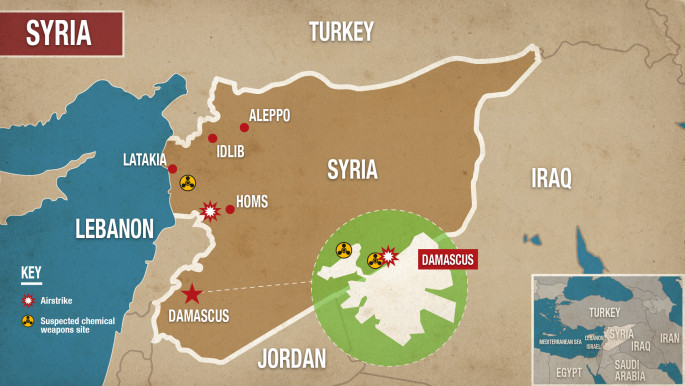Syria airstrikes: What happened and why?
Syria has been hit by a series of airstrikes by a US-led force. What happened, what were the targets, what was the damage, and why did it take place?
3 min read
A research facility in Damascus was one of the targets [AFP]
US, British and French armed forces launched a barrage of missiles on three sites in Syria early Saturday morning, choosing targets in the Damascus and Homs areas.
The Syrian regime and its ally Russia claimed the majority of the missiles were shot down, but Paris, London and Washington have questioned this and said the raids were successful.
A UN Security Council meeting has been called to address the crisis, which will likely see the US and Russia butt heads in the meeting.
What happened?
Both sides are telling very different stories at present, but what is known is that US, French and UK forces launched a series of airstrikes - using cruise missiles - at chemical weapons facilities in Syria on Saturday morning.
Four British RAF Tornado jets took part in the strikes from Cyprus, launching cruise missiles at targets in Homs.
French fighter jets took part in the strikes from the Mediterranean. The US used "land and sea platforms" from Qatar, the Red Sea, and Mediterranean to hit targets in Damasus and Homs.
Washington said 105 weapons were used in the strikes, while Russia put the figure at 110.
Why did it happen?
On Saturday, a chemical attack was launched on the opposition town of Douma, Eastern Ghouta following weeks of heavy bombing.
Douma, held by Jaish al-Islam, was the final town to hold out to the regime, but the gas attack forced the rebels to surrender.
France have said they have proof that the Syrian regime carried out the attack.
The US has claimed chlorine and likely a nerve agent were used to kill at least 40 civilians.
What was targeted?
A research centre in Damascus' military zone was among the targets, and Syrian regime footage has shown buildings in the area it said was heavily damaged by rockets.
It was described as the Scientific Studies and Research Centre in the Mezzeh district, where other military and security facilities are based.
A chemical weapons storage facility and command post west of Homs city were also targeted in the strikes.
Was it successful?
Russia has claimed that 71 of the 110 cruise missiles were shot down by Soviet-era Syrian air defence systems.
The Pentagon said that "successfully hit every target" and that the three sites selected for the missiles are "fundamental components of the regime's chemical weapons infrastructure".
It added that the strikes had put Syria's chemical weapons programme "by years".
France and the UK have also insisted that the missiles all reached their targets. Paris said that a significant part of Damascus' chemical weapons arsenal and weapons had been destroyed in the strikes.
No casualties have been reported, although Damascus earlier claimed that three civilians were injured.
France said it informed Moscow prior to the airstrikes being launched, and areas that the Russian military are active were avoided.
What now?
US Defence Secretary Jim Mattis has described the strikes as a "one off", while President Donald Trump proclaimed "mission accomplished" on Saturday.
There are unlikely to be any further strikes and the targets were far more limited than what was expected.
Russia has called for an emergency UN Security Council meeting to address the subject, but for now it appears the mission is over.

The Syrian regime and its ally Russia claimed the majority of the missiles were shot down, but Paris, London and Washington have questioned this and said the raids were successful.
A UN Security Council meeting has been called to address the crisis, which will likely see the US and Russia butt heads in the meeting.
What happened?
Both sides are telling very different stories at present, but what is known is that US, French and UK forces launched a series of airstrikes - using cruise missiles - at chemical weapons facilities in Syria on Saturday morning.
Four British RAF Tornado jets took part in the strikes from Cyprus, launching cruise missiles at targets in Homs.
French fighter jets took part in the strikes from the Mediterranean. The US used "land and sea platforms" from Qatar, the Red Sea, and Mediterranean to hit targets in Damasus and Homs.
Washington said 105 weapons were used in the strikes, while Russia put the figure at 110.
Why did it happen?
On Saturday, a chemical attack was launched on the opposition town of Douma, Eastern Ghouta following weeks of heavy bombing.
Douma, held by Jaish al-Islam, was the final town to hold out to the regime, but the gas attack forced the rebels to surrender.
France have said they have proof that the Syrian regime carried out the attack.
The US has claimed chlorine and likely a nerve agent were used to kill at least 40 civilians.
What was targeted?
A research centre in Damascus' military zone was among the targets, and Syrian regime footage has shown buildings in the area it said was heavily damaged by rockets.
It was described as the Scientific Studies and Research Centre in the Mezzeh district, where other military and security facilities are based.
A chemical weapons storage facility and command post west of Homs city were also targeted in the strikes.
 |
| [click to enlarge] |
Was it successful?
Russia has claimed that 71 of the 110 cruise missiles were shot down by Soviet-era Syrian air defence systems.
The Pentagon said that "successfully hit every target" and that the three sites selected for the missiles are "fundamental components of the regime's chemical weapons infrastructure".
It added that the strikes had put Syria's chemical weapons programme "by years".
France and the UK have also insisted that the missiles all reached their targets. Paris said that a significant part of Damascus' chemical weapons arsenal and weapons had been destroyed in the strikes.
No casualties have been reported, although Damascus earlier claimed that three civilians were injured.
France said it informed Moscow prior to the airstrikes being launched, and areas that the Russian military are active were avoided.
What now?
US Defence Secretary Jim Mattis has described the strikes as a "one off", while President Donald Trump proclaimed "mission accomplished" on Saturday.
There are unlikely to be any further strikes and the targets were far more limited than what was expected.
Russia has called for an emergency UN Security Council meeting to address the subject, but for now it appears the mission is over.






 Follow the Middle East's top stories in English at The New Arab on Google News
Follow the Middle East's top stories in English at The New Arab on Google News


